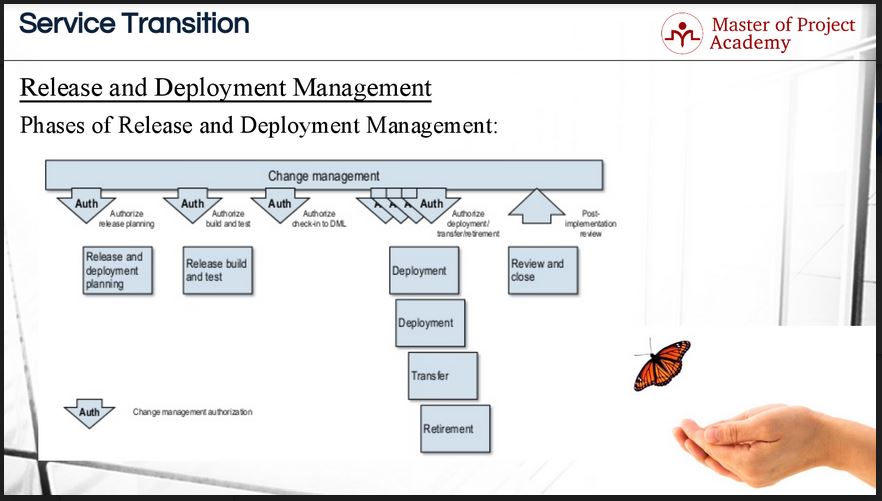There are different phases of the release management process that need to be followed by an IT Service Provider. The importance of this process and its 5 phases are discussed in detail in ITIL courses or asked about in the ITIL exam for that matter. This process is a key process in the ITIL Service Transition stage of the ITIL lifecycle. The release management process is also closely linked to the change management process. This process is also the stepping stone from the Service Transition Stage to the ITIL Service Operation stage where live services are accessible to the customer or end-user. Let’s have a look at the 6 stages and how it links to the deployment of new or upgraded services.

The 6 stages of the release management process
This figure describes the high-level overview of each phase. As you can see, the entire process is linked to the change management process. There are four authorization steps that feed out from change management and one release management process step that feeds into the change management process.

Release management process: release and deployment planning
As you see, the first step is the planning of release and deployment management. And this planning is authorized under the control of change management by the relevant parties in the IT service provider. As with any process, the release management process planning stage plays a critical role. Proper planning affects the efficiency of all the other phases of the release management process. Release management and deployment planning ensure that action plans for any possible mishaps are in place so that the release and deployment process can run smoothly.
Release management process: building and testing
Based on the release and deployment planning, service packages are released, built and tested respectively. There will be new requirements coming from the business or customer and also there will be problems or bugs on production. In order to meet the new requirements of the business and customer, and also fixing the problems that occurred in production will require the development of new services or changes in existing services. Each change in services must be authorized and after the service package is built and released, it must be tested to prevent any problems that can happen in production. This phase of the release management process repeats itself until the test run is perfect. Then the final service can be signed off by the person liable for change management.

Release management process: definitive media library
Then in the next step, updates are checked into the definitive media library. The definitive media library is the virtual space in which all services and their configuration items are stored. Only tried and tested configuration items and services can be part of the definitive media library and IT developers may only use items stored in the definitive media library to build new services. That is why the previous two steps of the release management process are so important. A thoroughly tested new service can be included into the definitive media library without hesitation.
Deployment of new services packages
Now it’s time for released, built and tested service packages to be deployed into the production environment for the use of the customers. Deployments of new service packages will take place after each change until the services are retired. After every change, the new version will be checked into the definitive media library. The constant evolution of the service is what keeps the service alive and well and adding value for the customer and the business.
Review and close
And at the end of each deployment, review and close phase starts. At this phase, a post-implementation review is done to evaluate the deployment of the new service package into the production environment for the use of the customers. The new service packages must be closely monitored to ensure that it reaches its service level targets as defined during the Service Design stage. If the new service does not deliver on its service level targets, the service needs to be updated to improve its performance and it will go through the whole process again. The value of the service to the clients and the business must also be closely monitored. It may come to a point where the service is no longer creating value to the company or are no longer relevant to the company’s corporate strategy. In that case, the service will be retired.
Release management process software
There are several IT service management software packages available that help to automate the release management process. These software packages are designed to error-proof your release management process from the planning stage to the deployment stage. They assist in thorough sandbox testing before moving into production. They also help to minimize the impact by closely evaluating relationships between services and highlighting services that may be affected by the release of the new planned service.
The release management process is the key process used to release and deploy services into a live environment where customers can use the service. Proper planning of the release management process and extensive checking and testing is critical to ensure that there are no bugs or other problems when the service is released. After deployment, service owners must be quick to fix any bugs before it affects the satisfaction of the business and the customer.
The Service Transition stage is where services advance from an idea in the Service Strategy stage and a concept in the ITIL Service Design stage to an usable and real-life service that can be deployed for public use. The Service Transition Stage consists of many processes: change management, service asset and configuration management and finally release and deployment management. All of these processes contribute to evolving services from concepts to services ready for deployment. Of these, the release management process is the final and most critical process as this is where the final steps are taken towards having a real-life service in a public environment. The change management process oversees the release management process, while the service asset and configuration management process runs in the background.
Review by: Derek Freeman
